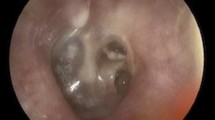Abstract
To clarify the usefulness of modified soft-wall reconstruction method by combing with mastoid obliteration, 96 patients (98 ears) with their age ranging from 5 to 82 (average 51.3), including 62 ears with chronic otitis media (COM) with cholesteatoma, 18 ears with non-cholesteatomatous COM, 14 ears with postoperative cavity problem, and 4 ears with adhesive-type COM, who had soft-wall reconstruction of the posterior ear canal and mastoid obliteration using mainly bone powder following mastoidectomy, were evaluated their postoperative conditions more than a year after surgery. Overall success rate was 76.5% (75/98), and fresh cases showed better success rate (84.8%) than those with a history of multiple surgeries (69.2%). Among unsuccessful cases, crust and/or debris accumulation was observed most (nine ears), followed by persistent wet condition (seven ears), and exposure of the obliterated material (five ears), while only two ears showed a retraction pocket formation. The success rates remained almost the same among those who were followed for more than 2 and 3 years (46/61, 75% and 21/28, 75%, respectively). In 60 ears on which postoperative hearing was assessed, 41.7% showed less than 15 dB of air-bone gap (ABG), and 61.7% showed less than 20 dB of ABG. Mastoid obliteration with bone powder in combination with soft-wall reconstruction of the posterior ear canal appeared a useful method for obliterating mastoidectomized cavity especially for prevention of postoperative pocket formation.



Similar content being viewed by others
References
Smith PG, Stroud MH, Goebel JA (1986) Soft-wall reconstruction of the posterior external ear canal wall. Otolaryngol Head Neck Surg 94:355-359
Takahashi H, Hasebe S, Sudo M, Tanabe M, Funabiki K (2000) Soft-wall reconstruction for cholesteatoma surgery—reappraisal. Otol Neurotol 21:28–31
Hosoi Y, Murata K (1994) Tympanoplasty with reconstruction of soft posterior meatal wall in ears with cholesteatoma. Auris Nasus Larynx (Tokyo) 21:69–74
Takahashi H, Honjo I, Naito Y, Miura M, Tanabe M, Hasebe S (1998) Cause of posterior canal wall retraction after surgery from viewpoint of mastoid conditions. Otol Neurotol 19:131–135
Takahashi H, Honjo I, Naito Y, Miura M, Tanabe M, Hasebe S, Toda H (1997) Gas exchange function through the mastoid mucosa in ears after surgery. Laryngoscope 107:1117–1121
Bonding P, Henrichsen J (1989) Results of a modified canal wall up technique with obliteration in cholesteatoma. In: Tos M et al (eds) Cholesteatoma and mastoid surgery. Kugler and Ghedini, Amsterdam, pp 871–873
Hormann K (1989) Mastoid obliteration. In: Tos M et al (eds) Cholesteatoma and mastoid surgery. Kugler and Ghedini, Amsterdam, pp 871–873
Gyllencreutz T (1992) Reconstruction of the ear canal wall using hydroxylapatite with and without mastoid obliteration and by obliteration with bone chips. Acta Otolaryngol (Stockh) 492:144–146
Takahashi S, Nozaki M, Urano M, Nakano Y (1994) Problems of the open mastoid cavity (in Japanese). Pract Otorhinolaryngol (Kyoto) 87:317–323
Saito T, Ohtsubo T, Tsuda G, Yanmada T, Noda I, Saito H (1997) Mastoid obliteration in combination with staged tympanoplasty for middle ear cholesteatoma. In: Sanna M (ed) Cholesteatoma and mastoid surgery. CIC Edizioni nternazionali, Roma, pp 650–653
Aristegui M, Villazon L, Fdez Fernandez-Vega L, Rdez Jozano N (1997) Canal wall down mastoidectomy with partial obliteration for the management of middle ear cholesteatoma. In: Sanna M (ed) Cholesteatoma and mastoid surgery. CIC Edizioni Internazionali, Roma, pp 706–709
Yamamoto Y, Hashimoto S, Nakano Y, Takahashi S (2001) Long-term results of canal down tympanoplasty with mastoid obliteration in cholesteatoma. In: Magnan J et al (eds) Proceedings of the 6th International Conference on Cholesteatoma & Eear Surgery. Label Publications, Marseille, pp 989–993
Gantz BJ, Wilkinson EP, Hansen MR (2005) Canal wall reconstruction tympanomastoidectomy with mastoid obliteration. Laryngoscope 115:1734–1740
Author information
Authors and Affiliations
Corresponding author
Additional information
This paper was presented at the 139th Annual meeting of American Otological Society, in Chicago, IL, USA on May 20, 2006, and its abstract appeared in the Transactions of the American Otological Society, Inc.
Rights and permissions
About this article
Cite this article
Takahashi, H., Iwanaga, T., Kaieda, S. et al. Mastoid obliteration combined with soft-wall reconstruction of posterior ear canal. Eur Arch Otorhinolaryngol 264, 867–871 (2007). https://doi.org/10.1007/s00405-007-0273-5
Received:
Accepted:
Published:
Issue Date:
DOI: https://doi.org/10.1007/s00405-007-0273-5




